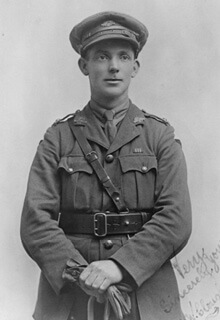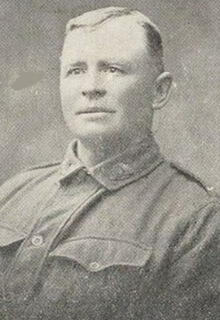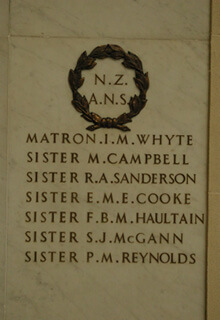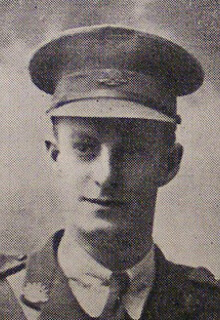At 5 am on 11 November 1918, three German government representatives accepted the Armistice terms presented to them by an allied commander, General Ferdinand Foch of the French Army. The Armistice became effective at 11 am the same day, and the 4-year long First World War ended.
After World War II, the Australian Government agreed to the United Kingdom’s proposal that Armistice Day be renamed Remembrance Day to commemorate those who were killed in both World Wars.
In October 1997, the then Governor-General issued a Proclamation declaring 11 November as Remembrance Day – a day to remember the sacrifice of those who have died for Australia in wars and conflicts.
Here, OpusXenta looks at four stories from four of our partner cemeteries that remind us why we should all pause to remember the men and women who faced their battles in distant lands with courage, strength and dignity.
Deeds that never should be forgotten.
Lieutenant Horace Webster Clough – Recipient of the Military Medal and Military Cross

Ballarat (New) General Cemetery, Victoria, Australia – a beautiful 55-hectare landscape of peaceful reflection, tranquillity, and a stunning resting place for the more than 78,000 famous, and infamous, figures who shaped Ballarat’s colourful history.
When 24th Infantry Battalion Lieutenant Horace Clough went to his grave at the Ballarat (New) General Cemetery in Victoria, Australia, in August 1959, a chapter closed on one of Australia’s most heroic wartime events.
The Military Medal and Military Cross recipient, who died of natural causes at age 68, not only showed himself to be a brave soldier but a natural leader during the attack on Montbrehain, northern France – the last action involving Australian infantry on the Western Front in the First World War.
As Horace’s war record graphically tells us:
During the attack on Montbrehain on 5 October 1918, he found that this company had become detached from the company on his right.
With five men, he went out under heavy machine gun fire and endeavoured to establish connection, four of his five men being killed.
On his return, he found that his company commander had been killed, and he took charge of the company, and by daring reconnaissance’s alone whenever his company was held up, was responsible for the continued advance.
Somewhat stoically and understatedly, the report concludes:
He showed great courage and initiative throughout this day.
Upon his return home at wars end, the former butcher and accomplished rower and footballer’s efforts were lauded by the Bendigo Advertiser newspaper, which printed:
Horace Clough returned home in May 1919 with the rank of Lieutenant after four years’ service from the cliff face of Lone Pine on Gallipoli to the final ADF battle on the Western Front.
He wrote extensively to family at home, and many of these letters were published in the three Bendigo area newspapers throughout the years of The Great War.
Henry Jenkins – Australia’s oldest enlisted wartime soldier

Carr Villa Memorial Park, Launceston, Tasmania Australia – since 1905, Carr Villa Memorial Park has been an integral and respected part of the community, occupying 50 hectares of land between Kings Meadows and Norwood in the city’s South-East,
Henry (Harry) Jenkins takes his place on the honour roll of Australian defence history as the oldest front-line soldier in World War II.
Enlisting when he was 55, Henry saw three and a half years of active service in France, enlisting in the Mining Battalion in 1915 before being drafted into the 3rd Tunnelling Company in France.
Tragically, Henry’s eldest son, who was attached to the 26th Battalion of Signallers, was killed in action in France in 1916.
According to the Virtual War Memorial Australia, Henry was born at Bromley in Kent, England, on November 11, 1860, exactly 58 years before the Armistice was signed.
Quite the journeyman, he arrived in Adelaide, South Australia on June 28, 1884, and landed in Tasmania 11 years later, where he was a farmer for many years.
He saw three and half years of active service, including being attached to the quarter-master’s staff with his company from the middle of 1917 until the Armistice.
Henry served without missing any duties, and ever the proud serviceman, he remained in uniform from the time he enlisted until he received his discharge.
He returned to his beautiful Tasmanian home in 1919 and passed away of natural causes in Launceston on 9 October 1942, aged 81 years.
Ruth Ada Sanderson – Nurse and co-owner of the Cassel Hospital

Hamilton East Cemetery, Hamilton City, Waikato, New Zealand – The Hamilton East Cemetery shows an early influence of John Loudon (1943 – 1843) in the symmetrical layout and use of evergreen trees. More recently, the ‘Lawn Cemetery’ section was developed and the Returned Servicemen’s area, influenced by the War Graves tradition.
Born on 5 October 1882 in Auckland, Ruth Sanderson joined the New Zealand Army Nursing Service and served on the WWI hospital ships Maheno and Aparima on the other side of the world.
Between July and October 1916, the Maheno carried 15,822 casualties of the Somme offensive across the English Channel.
It’s hard to conceive today how far away the battlefields of Europe must have been to the New Zealand servicemen and servicewomen who served so gallantly on those faraway shores and seas.
On her return to her homeland in 1920, Ruth and Sister Lara Hawkins opened Cassel Hospital in Von Tempsky Street, Hamilton East.
Sadly, Ruth became ill in 1923 with tuberculosis contracted during the war and died in 1928 aged 45 years despite years of treatment.
But today, she does not rest alone and is indeed in fine and kindred company.
In the most northern row of the Hamilton East Cemetery are the graves of two other nurses who served in war.
Matron Isabel M. Whyte of the Imperial Nursing Service, who received the Medaille de la Reine Belgique and the Royal Red Cross twice, and Sister Phoebe Mary Reynolds of the New Zealand Army Nursing Service, who was invalided home in 1917 and was ill until her death in 1923 are there too.
Lionel Samuel Douglas Martin – Lieutenant in the Australian Army

Rye Cemetery and Memorial Gardens, Rye, Victoria, Australia – Rye’s cemetery was gazetted in 1868, with the oldest identifiable headstone dated 1859, The cemetery has many graves and memorials relevant to the district’s history, including the grave of Lieutenant Lionel Martin and a memorial to Ernest Myers, who was the only young man from Rye to die in the First World War on the Western Front 16th November 1816.
Lionel Martin was born on 5 May 1892 and enlisted in the Australian Army in 1916, serving with the 10th Machine Gun Company.
His unit embarked into the unknown from Melbourne, Victoria, on board HMAT A11 Ascanius on 27 May 1916.
Upon arrival in Europe, Lionel served on the frontlines in England, Egypt, France and Belgium and was promoted to Lieutenant in 1917.
After serving in some of The Great War’s most bloody theatres, he returned to Australia in 1919 to marry the love of his life, Iona, the same year.
Moving to Rye in 1927, Lionel took up the position of Headmaster and retired from the teaching profession when he was 70.
The avid cricketer, footballer and football goal umpire in his twilight years, he was also a Foundation Member of the Rye Returned Services League (RSL) and was fittingly awarded its first Life Membership.
Lionel passed away in 1976 and lies restfully beside his beloved Iona.
The Ode
They shall grow not old, as we that are left grow old;
Age shall not weary them, nor the years condemn.
At the going down of the sun and in the morning
We will remember them.
